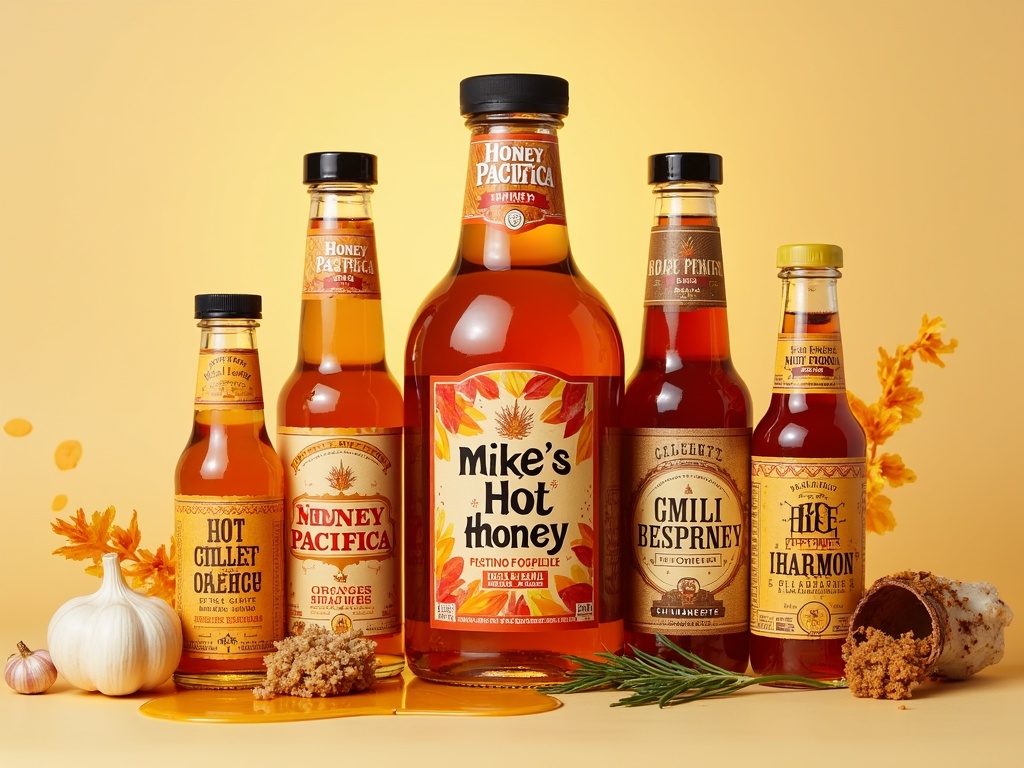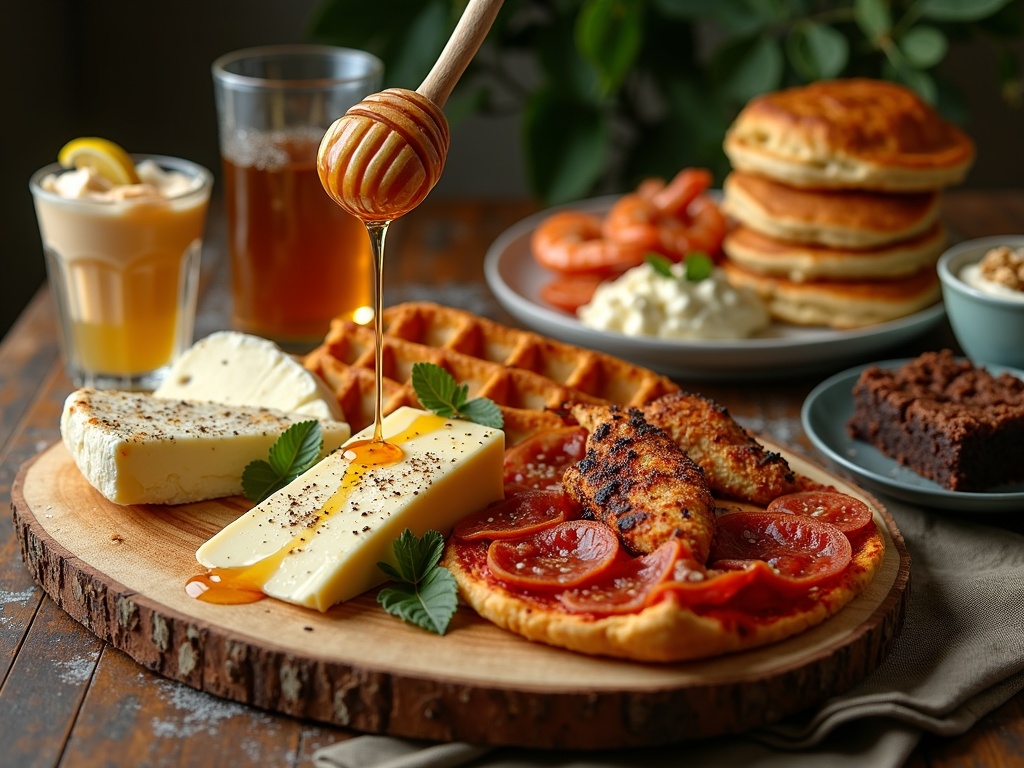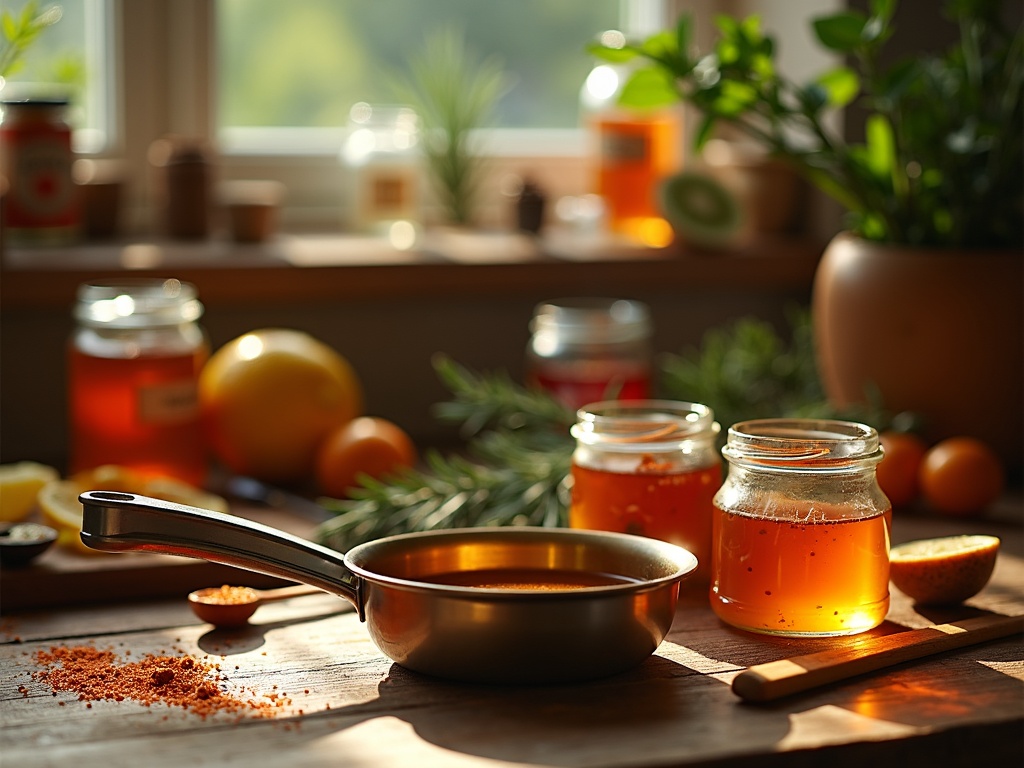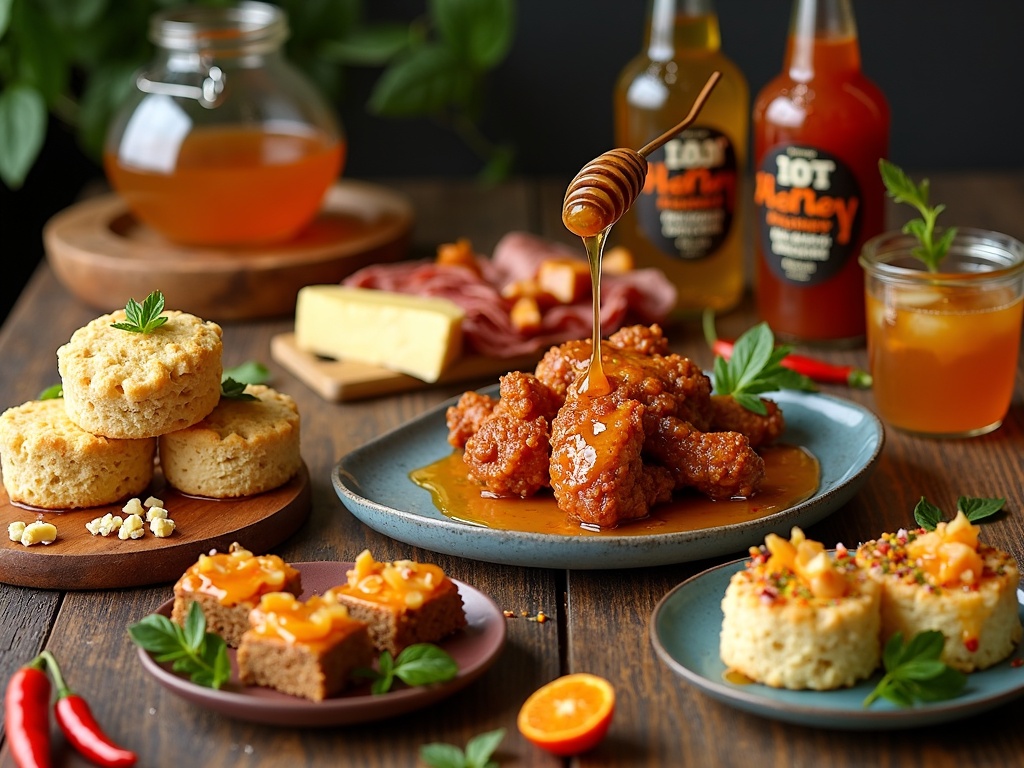Hot honey has transformed from a Southern kitchen secret to a nationwide sensation. Market projections estimate growth to $400 million by 2028 at an 8.6% CAGR. This versatile condiment combines the natural sweetness of honey with the bite of chili peppers, creating a complex flavor profile that enhances everything from pizza and fried chicken to cocktails and desserts.
Find In This Article
Key Takeaways
- Hot honey varieties range from mild (5,000 Scoville units) to extremely spicy (100,000+ Scoville units), allowing consumers to find their perfect heat level.
- The condiment offers surprising health benefits, combining honey’s antioxidant properties with capsaicin’s metabolism-boosting effects.
- Hot honey works exceptionally well on cheese boards, drizzled over breakfast foods, glazed onto grilled meats, and even incorporated into desserts.
- Making homemade hot honey is simple and economical, requiring just quality honey, red pepper flakes, and optional additions like herbs or citrus zest.
- Beyond its culinary applications, the hot honey market shows strong growth potential with 65% of consumers actively seeking spicy food products.
The Sweet and Spicy Revolution Taking Over Your Kitchen
I’ve watched hot honey transform from a Southern kitchen secret to a nationwide sensation, and the numbers back up this sticky revolution. The market hit an impressive $245 million in 2022 and isn’t slowing down anytime soon. Experts project it’ll reach a sizzling $400 million by 2028, growing at a robust 8.6% CAGR. This isn’t just another food trend—it’s a flavor movement with staying power.
Why We’re All Buzzing About Hot Honey
The appeal makes perfect sense when you consider that 65% of consumers actively seek out spicy food products. This perfect marriage of sweetness and heat delivers a complexity that plain honey simply can’t match. The contrast between the natural sweetness of honey and the bite of chili peppers creates a flavor experience that enhances everything from cheese boards with cured meats to drizzles over your morning biscuits.
Hot honey traces its roots to the Southern United States, where home cooks have long understood how a touch of heat can transform traditional recipes. What started in family kitchens has now become a staple in restaurants and grocery stores nationwide. The combination taps into our growing appetite for layered flavors that deliver both comfort and excitement in each bite.
For those concerned about the heat factor, I’ve found hot honey offers something for everyone. The spice levels vary dramatically, ranging from a mild 5,000 Scoville units (comparable to a jalapeño) to a fiery 100,000+ Scoville units for the truly heat-obsessed. Many brands offer different heat levels, making it easy to find your perfect match whether you’re a spice novice or a heat seeker.
Versatility Beyond Your Wildest Dreams
What’s driving this growth isn’t just the flavor but the incredible versatility. I’ve discovered hot honey works in virtually any situation where you’d use regular honey—and then some. Here are some favorite applications that have converted even skeptics:
- Drizzled over bite-sized desserts for an unexpected sweet-heat finish
- Paired with rich chocolate brownies to create a flavor contrast that’s absolutely addictive
- Brushed onto grilled meats as a glaze that caramelizes beautifully
- Stirred into cocktails for a spicy-sweet kick
- Mixed into salad dressings to elevate simple greens
- Added to marinades for depth and complexity
- Drizzled over homemade honeycomb candy for a spicy-sweet treat
The appeal of hot honey isn’t limited to savory applications. It’s finding its way into banana-based desserts and even rocky road treats where the heat cuts through the sweetness for a more balanced flavor profile.
What I find particularly fascinating is how hot honey bridges culinary traditions. It works brilliantly in everything from traditional Southern cuisine to modern fusion dishes. The product’s adaptability speaks to our evolving palates and desire for ingredients that can work across multiple cooking styles.
With its impressive growth trajectory and widespread appeal, hot honey has secured its place as more than a passing trend. It’s become a kitchen essential that continues to find new applications as home cooks and professional chefs experiment with its unique flavor profile. Whether you’re a cooking novice or an experienced chef, this sweet-heat combination offers an easy way to transform ordinary dishes into something extraordinary.

Leading Brands and Flavor Variations
The hot honey market has expanded dramatically since Mike’s Hot Honey pioneered the first commercially bottled product. I’ve found this original creation set the standard with its perfect balance of sweetness and heat, inspiring numerous competitors to enter the space with their own unique twists.
Top Hot Honey Brands
When exploring quality hot honey options, several brands stand out for their distinctive approaches:
- Honey Pacifica offers artisanal hot honey varieties that emphasize locally-sourced ingredients and sustainable beekeeping practices.
- Chili Pepper Madness produces versions that cater to heat enthusiasts, with options ranging from mild to extremely spicy.
- Bee Harmony creates hot honey with a focus on supporting pollinator health, resulting in complex flavor profiles.
Each brand brings something unique to the table, whether it’s heat intensity, honey sourcing, or production methods. The price points vary considerably too, with artisanal options typically commanding premium prices between $12-20 per bottle, while more accessible versions can be found around the $8-10 range.
Honey Bases and Flavor Infusions
The base honey variety significantly impacts the final flavor profile of hot honey products. Clover honey provides a clean, mild foundation that lets the heat shine through, while wildflower honey creates deeper complexity with floral notes. Orange blossom honey adds citrus undertones that complement certain chili varieties beautifully.
Beyond the honey base, brands have gotten creative with additional infusions. Garlic-infused hot honey works wonderfully on pizza and charcuterie boards with sharp cheeses. Rosemary-infused versions pair perfectly with roasted meats and vegetables, adding an herbal dimension. Cinnamon-spiced hot honey creates a warming effect that’s ideal for dessert applications or breakfast foods.
The heat levels also vary dramatically across products. Some brands focus on a gentle warmth that won’t overwhelm sensitive palates, while others cater to spice enthusiasts with intense heat that builds slowly. I’ve noticed many brands now include heat indicators on their packaging to help consumers find their perfect match. This range in heat intensity makes hot honey accessible to everyone from spice novices to dedicated chiliheads.

Surprising Health Benefits You Should Know
Hot honey isn’t just a delicious condiment – it’s packed with wellness perks that might surprise you. This spicy-sweet treat combines the natural goodness of honey with the kick of chili peppers, creating a powerhouse of health benefits.
Nutritional Powerhouse
Pure honey serves as a natural antioxidant goldmine, fighting free radicals that can damage cells. I’ve found that replacing refined sugars with honey in my diet has made a noticeable difference in my overall wellbeing. The antioxidants in honey help protect your body from oxidative stress and inflammation.
The capsaicin found in chili peppers gives hot honey its signature heat while boosting your metabolism. This compound can increase calorie burning and fat oxidation, making it a smart addition to your meal plan if you’re looking to maintain a healthy weight.
Athletes can benefit from a spoonful of hot honey before hitting the gym. The natural sugars provide quick energy, while capsaicin improves blood flow and oxygen delivery to muscles during workouts. I often add a drizzle to my homemade energy bites for an extra pre-workout boost.
The antibacterial properties of hot honey shouldn’t be overlooked. Honey has long been recognized for its ability to fight certain bacteria, and when combined with the antimicrobial effects of chili peppers, it creates a potent combination that can help support your immune system.
For those with digestive concerns, hot honey might offer some relief. The soothing properties of honey paired with capsaicin’s ability to stimulate digestion can help maintain gut health. Adding a touch to your favorite cheese board isn’t just tasty – it’s supporting your digestive system too.
Hot honey can be incorporated into your diet in numerous ways:
- Drizzled over tiny desserts for a sweet-heat contrast
- Mixed into tea or warm water as a soothing drink
- Used as a glaze for roasted vegetables
- Incorporated into salad dressings for added dimension
- Swirled into yogurt or oatmeal for breakfast
The balance of beneficial compounds makes hot honey more than just a condiment – it’s a functional food that can play a role in your health regimen while adding incredible flavor to countless dishes. Just remember that moderation is key, as honey still contains natural sugars that should be consumed thoughtfully as part of a balanced diet.
Creative Ways to Use Your Hot Honey
Hot honey has transformed from a niche condiment to a kitchen staple in my home. Its perfect balance of sweetness and heat makes it incredibly versatile. I’ve found countless ways to incorporate this flavor-packed condiment into everyday meals.
Elevate Your Main Dishes
Pizza gets an instant upgrade with a drizzle of hot honey. I particularly love adding it to pepperoni pizza where the spicy-sweet combination cuts through the richness of the cheese and meat. For an unforgettable meal, try hot honey on fried chicken – the sticky sweetness paired with the crispy coating creates an irresistible contrast that’ll have you licking your fingers.
Grilled shrimp takes on a new dimension when brushed with hot honey during the last minute of cooking. The honey caramelizes slightly, creating a gorgeous glaze while the heat adds complexity to the seafood. Even simple glazed carrots become extraordinary when tossed with a tablespoon of hot honey before roasting – the natural sweetness of the vegetables intensifies beautifully.
Perfect Pairings and Accompaniments
Hot honey shines brilliantly on a carefully arranged cheese board with various textures and flavors. These pairings work exceptionally well:
- Creamy goat cheese topped with hot honey and a sprinkle of cracked black pepper
- Aged sharp cheddar with a small pool of hot honey for dipping
- Fresh ricotta drizzled with hot honey and a few thyme leaves
- Brie or camembert with hot honey and toasted almonds
Breakfast gets exciting with hot honey too. Pour it over buttermilk biscuits for a sweet kick that transforms an ordinary morning meal. It’s equally delicious on pancakes, waffles, or even stirred into yogurt with granola for a sweet-spicy crunch.
The cocktail world has also embraced hot honey as an ingredient. I’ve found it works wonderfully in a spicy margarita, whiskey sour, or even a hot toddy during cold weather. The heat builds gradually while the sweetness balances stronger spirits perfectly.
For something truly indulgent, try adding a small drizzle to homemade fudgy brownies just before serving. The surprising heat cuts through the chocolate richness and creates an unexpected flavor experience your guests will talk about for days.

Choosing the Right Heat Level
Finding the perfect balance of sweetness and spice in hot honey depends entirely on your heat tolerance. I’ve discovered that starting with a clear understanding of Scoville units can help you make better choices when selecting or making your own spicy honey concoctions.
Understanding the Heat Spectrum
Mild hot honey varieties typically measure around 5,000 Scoville units, making them perfect for beginners or those who prefer just a hint of warmth. These gentle options provide a subtle kick that won’t overwhelm the honey’s natural sweetness. They’re ideal for drizzling over charcuterie board creations where you want heat that complements rather than dominates.
Medium heat options generally range between 15,000-50,000 Scoville units and strike an excellent balance for everyday use. I’ve found these varieties versatile enough for both cooking and finishing dishes. They pair beautifully with fudgy brownies for an unexpected sweet-heat contrast that elevates simple desserts.
For true heat enthusiasts, extra spicy hot honey varieties exceed 100,000+ Scoville units. These intense concoctions aren’t for the faint-hearted but offer incredible depth when used sparingly. A tiny drizzle can transform mini dessert creations into sophisticated treats with complex flavor profiles.
Before committing to a particular heat level, I recommend conducting a simple test: place a small drop on your finger and taste cautiously. Your reaction will quickly tell you if you need to adjust up or down the heat scale. Another approach is the “honey spoon test” – dip a teaspoon in the hot honey and slowly taste, paying attention to how the heat builds.
When cooking with different heat levels, remember these guidelines:
- Mild varieties (5,000 Scoville units): Use liberally as finishing touches on dishes like pizza, fried chicken, or homemade honeycomb treats
- Medium heat (15,000-50,000 Scoville units): Add during the last few minutes of cooking to preserve flavor complexity
- Extra spicy (100,000+ Scoville units): Use extremely sparingly and primarily as a finishing element
The cooking process can either intensify or mellow hot honey’s heat, depending on application. I’ve noticed that incorporating hot honey into baked goods like banoffee desserts tends to tame the spice, while using it as a glaze for roasted vegetables can concentrate the heat.
For adventurous palates, trying a rocky road recipe with a drizzle of hot honey creates an unexpected contrast that highlights both the sweetness and spiciness in a memorable way.
Make Your Own Signature Blend
Creating your own hot honey at home is surprisingly simple and far more economical than store-bought versions. I’ve been perfecting my recipe for years, and the customization possibilities are endless. With just a few ingredients and some patience, you’ll have a versatile condiment that elevates everything from pizza to fried chicken.
Essential Ingredients and Process
To make basic hot honey, you’ll need:
- 1 cup of high-quality honey (raw, unfiltered honey offers the best flavor)
- 2-3 tablespoons of red pepper flakes (adjust based on your heat preference)
- Optional: 1 tablespoon of apple cider vinegar for balanced acidity
The infusion process is straightforward but requires attention to detail:
- Pour honey into a small saucepan and warm over low heat.
- Add red pepper flakes and stir gently.
- Maintain a low simmer for 5-10 minutes, watching carefully to prevent burning.
- Remove from heat and let steep for at least 1 hour (longer steeping intensifies flavor).
- Strain through a fine-mesh sieve if you prefer no flakes in your final product.
- Add vinegar if using, and stir to incorporate.
The key is keeping the heat low—honey burns easily and high temperatures can destroy its natural benefits. For gifting purposes, small jars of homemade hot honey make thoughtful presents that showcase your culinary skills.
Exploring Pepper Varieties and Customizations
Different peppers create distinctly different hot honey experiences. For beginners, I recommend starting with these options:
- Calabrian chilies: Fruity, bright heat that pairs beautifully with cheese
- Aleppo peppers: Moderate heat with cumin-like undertones
- Chipotle: Smoky depth with medium heat
- Thai bird chilies: Sharp, intense heat for those who crave serious spice
- Habanero: Fruity, tropical notes with significant heat
Beyond basic recipes, I’ve found adding complementary flavors creates truly unique hot honey blends that surprise and delight. Consider incorporating:
- Citrus zest (orange, lemon, or lime)
- Woody herbs like rosemary or thyme
- Warming spices such as cinnamon, star anise, or cardamom
- Garlic (adds savory depth)
- Fresh ginger (creates a zingy, aromatic quality)
Each addition should complement, not overwhelm, the natural sweetness of honey. I often make small test batches before committing to larger quantities.
Proper storage extends shelf life and preserves flavor. Store your hot honey in a clean, airtight glass jar at room temperature for up to 3 months. The natural antibacterial properties of honey, combined with the preservative effects of capsaicin from the peppers, create a stable product. If you notice crystallization, gently warm the jar in a hot water bath to restore fluidity.
The beauty of making your own signature hot honey blend lies in adapting it to your taste preferences. Start with small batches using a base recipe, then adjust heat levels and flavor additions until you find your perfect balance. Keep notes on what works—and what doesn’t—to refine your technique.
For an unexpected twist, try infusing honey with both chilies and complementary fruits like dried apricots or banana chips. The contrast between sweet, fruity notes and spicy heat creates complex flavors that transform ordinary dishes into memorable experiences.
Remember that hot honey develops and mellows over time. What might taste overly spicy on day one often settles into a more balanced profile after a week. Patience rewards the home cook with rich, nuanced flavors that can’t be rushed.

Sources:
Global Hot Honey Market Report 2023, Market Research Institute
Health Benefits of Honey: A Clinical Review, Journal of Medicinal Food
Exploring Culinary Uses of Honey, Culinary Institute of America

